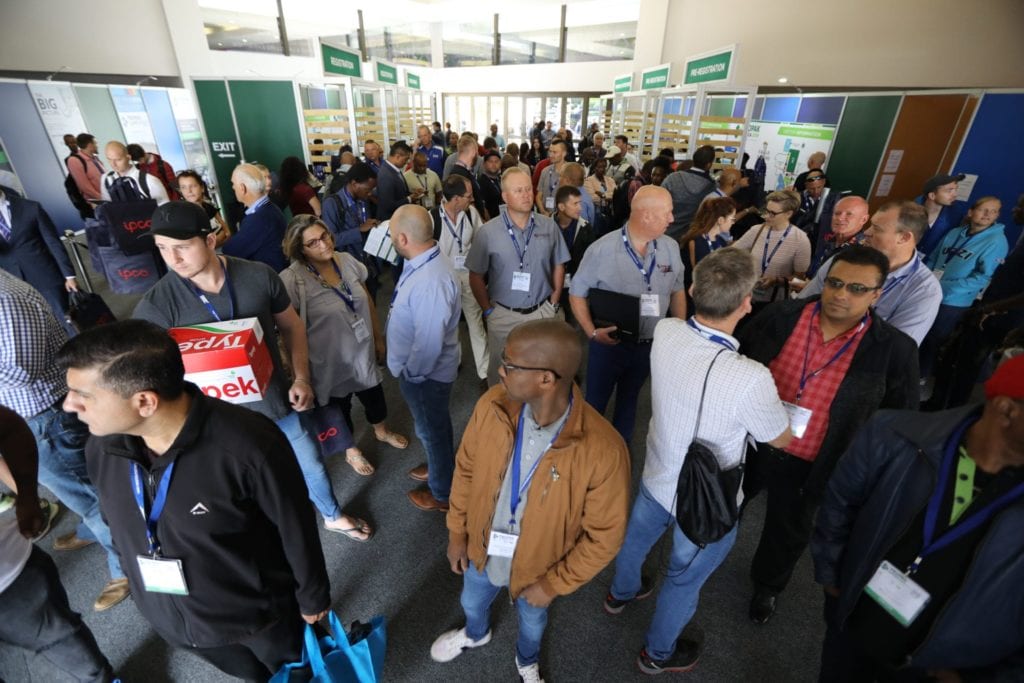According to the Centre for Exhibition Industry Research (CEIR), exhibitions are important for marketers to satisfy critical goals in identifying new customers, reaching sales leads, and building product and company awareness. B2B exhibitions are the face-to-face marketing channel of choice for brand marketers and are highly valued in achieving marketing and sales objectives.
“Trends indicate that exhibitions remain a valued part of overall marketing strategy across industries,” says Gary Corin, managing director of Specialised Exhibitions Montgomery.
“Although exhibitors may not be taking the very large stands of the past, they are still visibly active and present, as exhibitions enable them to showcase their brands and enjoy a good return on investment. Earlier this year, an exhibitor sold four machines within the first two hours of the show opening. Another exhibitor sold most of the equipment on his stand during the show, totalling almost R40 million in value. A positive upside to the reallocation of space is that new opportunities have been created for an additional number of companies to participate, bringing an even greater number of products and new technology to the fore.”
Visitors continue to attend exhibitions in high numbers, attracted by the opportunity to connect with industry experts, discover the latest industry trends, learn about the latest range of products and technologies, and garner more knowledge through the many seminars, conferences and workshops running alongside the events.
Exhibitions continue to evolve
Exhibitions have evolved to meet the changing needs of buyers and sellers. Although Specialised Exhibitions Montgomery has been organising exhibitions for over 50 years, the company is not old in its thinking. “As a company, we have adapted over the years and continue to innovate and rejuvenate the business to create a vibrant, energetic and forward-thinking environment that keeps us at the forefront of our industry. This applies to our people and our exhibitions,” says Gary. “I have a young team chasing me for the top job! We embrace their energy and empower them to grow and to take on new challenges.”
“Adapting to new ways of marketing, embracing the digital era, creating content, building partnerships, and streamlining operations and accounts are key to continued exhibition success,” he explains.

Embracing the digital platform
The purpose of exhibitions is to bring people together. Where you attract a lot of people, business happens. How you attract your audience is by embracing the digital age.
The number of tools, technologies and channels marketers can now select from has had an impact on the traditional way of doing business but, when it comes to the B2B environment, marketers still believe in the value of engaging with potential customers face to face. Exhibitions have the ability to create an interactive environment that can tap into all our senses through real or virtual experiences. Buyers can connect one on one with exhibitors while also watching the action of live demonstrations. At the same time, social media delivers highlights of what’s happening across the exhibition halls.
“Principles that underpin communications are still the same and much of the traditional marketing is still relevant, but instantaneous messaging through digital platforms and social media offers a whole new world of opportunity. Embracing both delivers a powerful integrated mix of communications that positively influences decisions to attend exhibitions. This includes the development of an app for each show,” says Gary.
Facebook, LinkedIn, Instagram and Twitter are among the most popular to motivate visitor attendance and to actively engage with visitors while at the show. Social media captures the experiences in video and pictures, instantly drawing attention to the event.
“By growing our online audience, the more potential attendees we can reach. Communication tools are used that perform best at converting pre-registered visitors to actual attendees. Pre-registered visitors are also prompted to invite friends and colleagues that are part of their network.
“In travelling extensively to visit exhibitions in developed and developing countries, it has been interesting to see that everywhere still utilises a mix of the traditional with the new. Alongside the new apps and Wi-Fi, you still get the printed materials that can be taken with you. People are still tactile and you need to give people something tangible.”
The future of exhibitions
According to the January 2019 UFI (Global Association of the Exhibition Industry) Barometer, 74% of companies researched globally reported an increase in turnover in the second half of 2018, with 63% anticipating an increase in the first half of 2019, and 69% for the second half of 2019.
Specific to South Africa, 86% of exhibition companies reported an increase in turnover for the second half of 2018, with an anticipated 38% for the first half of 2019, and 27% in the second half of 2019, with a further 40% unsure about the latter part of the year. This is likely linked to the current state of the economy in the home market, cited by 33% of companies.
The survey also looked at the ‘entertainment’ component of exhibitions. Results highlighted a good match between the views of exhibition companies with those from the visitors around the inclusion of talks and presentations delivered in different ways, new technology such as virtual reality, and informal networking. Future exhibitions will feature new activities and other live events or virtual events running in parallel.
“Consumers are hungry for knowledge and enjoy the journey that exhibitions take them on, from the time of pre-registration to the conclusion of their visit,” Gary adds. “We have seen this journey being enhanced even further with the new features we have added to our shows over the past year, and future virtual reality experiences with simulators are likely. Visitors will continue to see, touch and feel the products and machinery on the stand and see live demos, but virtual reality will enable visitors to further experience machinery in action in its working environment.”







